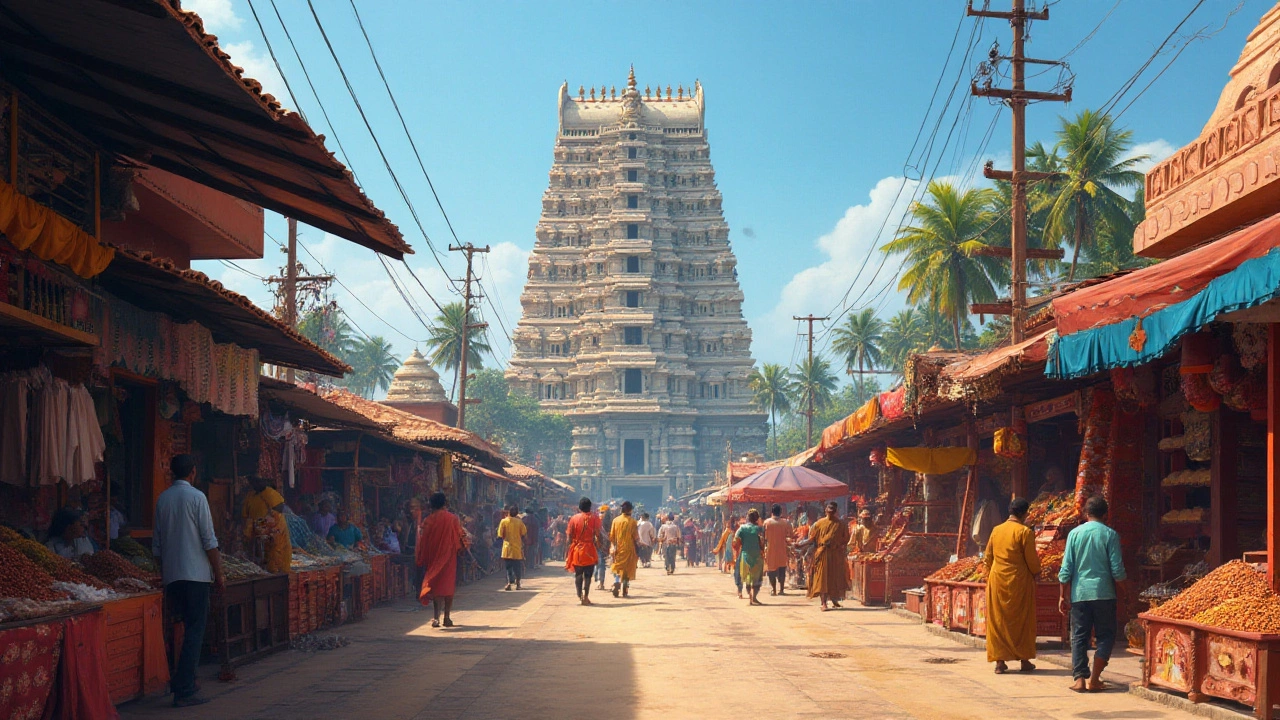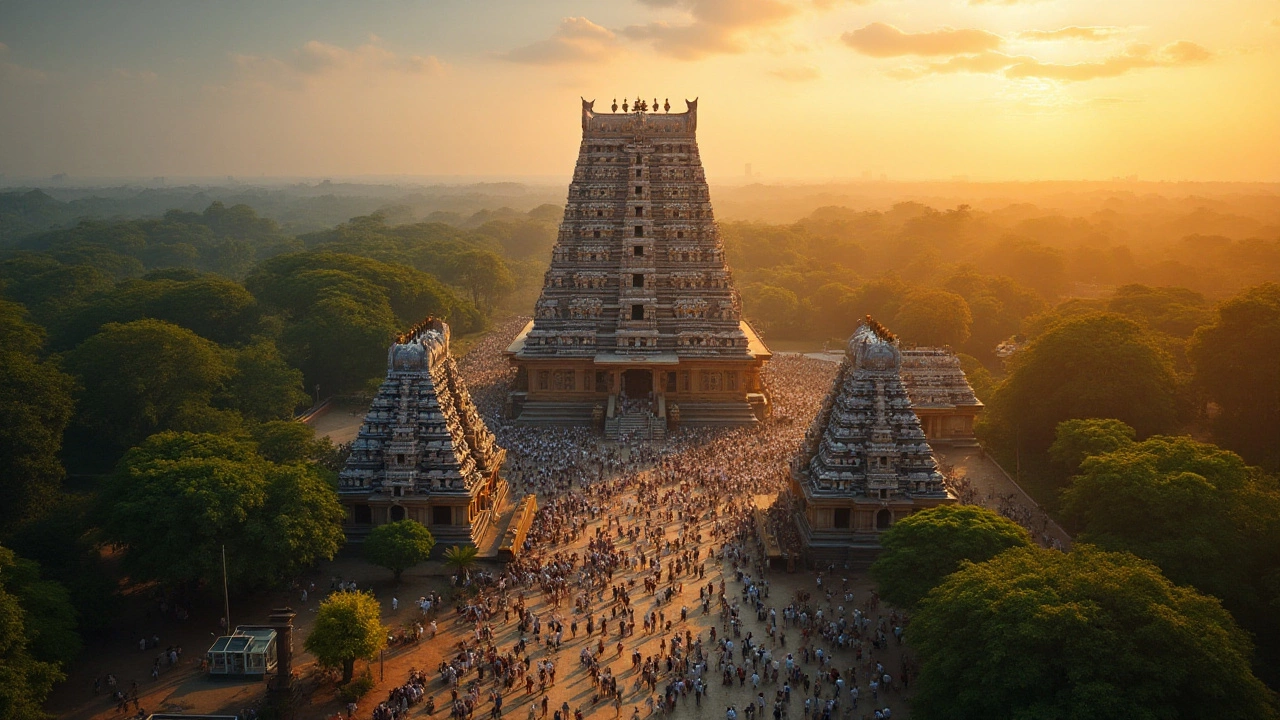Rameswaram, an island suffused with mythological wonder and profound spirituality, captivates visitors from all over the world. This enchanting destination in Tamil Nadu is celebrated for its majestic temples and the deep religious significance they hold. At the heart of this mystical land sits the illustrious Ramanathaswamy Temple, a splendid example of ancient Dravidian architecture and a monumental testimony to history and faith.
The town's proximity to both the captivating Pamban Bridge and the pristine beaches of Dhanushkodi further enhances its appeal, creating a harmonious blend of cultural heritage and natural beauty. Whether one's journey is motivated by faith, history, or awe-inspiring landscapes, Rameswaram offers a unique tapestry of experiences that are both fulfilling and enlightening. In these sacred waters and storied temples, every visitor finds a piece of enlightenment and peace.
- A Glance at Historical Significance
- The Architectural Marvel of Ramanathaswamy Temple
- Exploring Spiritual and Natural Wonders
- Practical Information for Visitors
A Glance at Historical Significance
Rameswaram is more than just a spot on the map; it is an epicenter of age-old tales and spiritual legends. As a sacred portal in Hindu mythology, it holds immense historical importance. Located in Tamil Nadu, this revered destination is steeped in a mystique closely tied to the Sanskrit epic, the Ramayana. According to legend, Rameswaram is where Lord Rama, a divine protagonist, constructed a bridge to Sri Lanka to rescue his consort Sita from the clutches of the demon king Ravana. This legendary bridge, known as Adam's Bridge or Ram Setu, though shrouded in time, continues to capture the imaginations and faith of pilgrims and storytellers alike. The spiritual aura and historical layers make Rameswaram a fascinating study of the ancient past meeting the present.
The history of Rameswaram is also cherished in the ancient texts, where it is exaltedly referred to as one of the char dham, or the four abodes. Devotees believe that visiting these sacred sites is a vital pilgrimage meant to cleanse one's soul. The serene island weaves through eras of dynastic reign including those of the Pandya, Chola, and Jaffna kingdoms, each leaving a palpable mark on its cultural tapestry. Different rulers contributed to the intricate carvings and sculptures adorning the temples, creating a blended beauty of art and devotion that can still be appreciated today.
In the records of history, the Ramanathaswamy Temple stands out with its awe-inspiring corridors and towering gopurams. Constructed mainly during the reigns of the Pandya and Jaffna kings, the temple boasts the longest corridor among all Hindu temples worldwide. The architecture exhibits a splendid symphony of art and spirituality, where every pillar and arch narrates silent stories of its era. One cannot ignore the meticulous granite sculptures that bring mythology to life, offering a tangible window into the confluence of history and myth. As T. S. Eliot once said, rewinding time through walls of antiquity allows us the space for self-reflection.
"The very existence of temples awakens the soul, reminding us that history is not a thing of the past, it is alive," - Anonymous Historian.The walls, echoing with the chants of ages, reflect the town's antique charm as a time capsule, where devotees seek solace and a déjà vu of divine energies.

The Architectural Marvel of Ramanathaswamy Temple
Hidden within the heart of Rameswaram lies one of India's most awe-inspiring gems, the Ramanathaswamy Temple. Renowned for its intricate design and sweeping corridors, this temple stands as a testament to the architectural brilliance of the Dravidian style. It is not only a spiritual beacon but also an engineering masterpiece that has captivated thousands over centuries. Walking through its sacred halls, one can't help but marvel at the architectural ambition and the sheer skill it would have taken to construct such an edifice in ancient times. The temple boasts the longest corridor among all Hindu temples in India, an impressive 1,220 meters graced with nearly 1,216 pillars, each expertly chiseled with elaborate carvings that narrate ancient stories and legends.
The temple's gopurams, or gateway towers, are towering structures that stretch towards the sky, marking the celestial ambitions of its creators. These gopurams are decorated with an array of statues depicting various deities, and their design showcases the detailed handiwork of artisans who lived centuries ago. A notable highlight is the second tallest gopuram in the world, standing majestically at an elevation of 53 meters adorned with vibrant colors that influence both local and external artists. Interestingly, it's said that each stone of this temple was hauled from materials sourced far and wide, brought together to form this complex that took centuries to reach its present glory.
The architecture doesn't simply rest in its grandeur; the temple encompasses sacred ponds known as 'teerthams', with 22 specific ones within the temple premises. These teerthams, believed to have holy properties, are part of a ritualistic cleansing process taken by devotees. The ancient texts recount that these waters have medicinal and spiritual qualities, enriching the soul and body alike. The ambitious layout of Rameswaram places the Ramanathaswamy Temple at its center, ensuring that visitors head towards it as their core objective. These 22 wells, with varying taste in water, symbolize the idea that every element in this universe has its unique characteristic, skillfully bringing spirituality and physics into perfect harmony. Observing these timeless architectural features gives every visitor a gateway into the minds and lives of people from eras long past, who managed to weave such ingenuity into stone.
"Rameswaram's sacred corridors reflect an unending passage of time, emblazoned by artistry and thought, persistent in their quest to recall the divine."
For those who step beyond the corridors and gaze up at the Vimana, the temple's towering sanctum that houses the central deity, it's easy to feel an overwhelming sense of serenity. Constructed with precision and balance, the Vimana is central to the spiritual practices within this hallowed space, architecturally crafted to draw the devotee's gaze upward, fostering a connection between heavens and earth. As a necessity for such wonder, detailed knowledge of geometry, stonework, and cosmic alignments guided the ancient builders whose unfaltering dedication brought forth the wonders we witness today. Fascinatingly, this unified synchrony reinforces the idea that Rameswaram is both an artistic and a spiritual utopia, inviting all those curious to immerse themselves within its boundless myths and spiritual significance.

Exploring Spiritual and Natural Wonders
Rameswaram, a significant pilgrimage town, offers an unparalleled journey into spirituality intertwined with nature's splendid offerings. Nestled on a serene island, bordered by gentle waves and azure skies, it envelops visitors in its unique charm. The enchantment begins at the stunning shores of Agni Theertham, a sacred place where pilgrims bathe in the gentle waters to cleanse their souls. This is a tradition believed to absolve all sins, enriching the believers' spiritual quest. While the beach serves as a foremost spiritual purification hub, it's also a visual delight, offering vistas of golden sands stretching tirelessly under the cerulean sky. The union of religious importance and serene landscapes here is truly mesmerizing, making Rameswaram a haven for those longing to harmonize their mind and spirit.
As one ventures further into Rameswaram, the ethereal beauty of the Pamban Bridge stands as a testament to human ingenuity and nature's spectacular allure. Spanning the turquoise waters, it connects the island to the mainland, crafting a scenic route filled with panoramic vistas. The thrill of crossing this engineering marvel is magnified as the stunning views seep into one's consciousness. The bridge, with its serene surroundings, serves as a mirror that reflects the idyllic charm of the region, its beauty touching the heart of every traveler.
The spiritual landscape of Rameswaram is further enhanced by the mystical allure of Dhanushkodi, a ghost town poised at the confluence of the Bay of Bengal and the Indian Ocean. Though labeled a ghost town, its haunting beauty is quite the opposite. Fine grains of sand dance with the winds, whispering secrets of the past as ruins breathe stories of resilience and rebirth. Standing at Land's End, travelers are spellbound by the terminus where sand seems to blend with the sky, and one can ponder infinity. This area, once the site of a formidable cyclone, now offers serenity and reflection, a profound complement to the spiritual aura of Rameswaram.
Adding another layer to the spiritual journey, the enchanting stories of Rameswaram are deeply rooted in its rich mythological tapestries. According to legend, the footprints of Lord Ram, an avatar of Vishnu, and his pursuit to save his wife Sita trace through these lands. The spiritual vibrancy is palpable in the temples, offering profound tales and symbolizing India's rich religious canvas. Equally captivating is the tale of the floating stones believed to have been used in the mythical construction of the Ram Setu, an ancient bridge to Sri Lanka. Such legends are not only fascinating but also elevate the sacred appeal of Rameswaram, drawing visitors into its age-old mystique.
Many people who have explored Rameswaram come back with tales of awe and wonder. As travel writer Ruskin Bond once beautifully articulated, "There is a kind of magic about going far away and then coming back all changed." Such sentiments resonate deeply with those who voyage through the spiritual and natural treasure troves of Rameswaram, for it is not just a destination but a soulful expedition into the mystical realms of faith and nature.

Practical Information for Visitors
Embarking on a journey to Rameswaram can be an exhilarating adventure filled with awe and serenity. As you plan your visit to this sacred town, keep in mind a few practical matters to ensure a smooth and enjoyable experience. Rameswaram is easily accessible by road and rail. The nearest airport is in Madurai, roughly 170 kilometers away, from where you can hire a taxi or take a bus to reach the island. Rameswaram is well-connected by trains from major cities like Chennai and Bangalore, making it a popular pilgrimage route for devotees.
Once in the town, the preferred mode of transport for experiencing the local vibe is by auto-rickshaws and bicycles. The town's compact size makes bikes an ideal choice for those seeking an immersive, eco-friendly option to explore the lanes of Rameswaram. When it comes to accommodation, a variety of options cater to different budgets ranging from budget lodges to more luxurious resorts, each promising warm hospitality. The ideal time to visit Rameswaram is between October and April, when the weather is pleasant for temple tours.
Visitors to Rameswaram are encouraged to dress modestly, embracing the local customs of temple attire. As you prepare to visit the Ramanathaswamy Temple, be mindful that entry is permitted only in traditional attire, with men required to remove their shirts in the inner sanctum. The temple operates on a day-long schedule, opening as early as five in the morning and closing by nine at night, though exact timings can vary slightly with seasons. While visiting, allocate generous time for the elaborate rituals and exploring the corridors, which are among the longest in any Hindu temple, spanning a mesmerizing 1,200 meters.
Water rituals and bathing in the 22 holy wells, known as 'theerthams', form a significant part of the pilgrimage and are believed to cleanse sins and bring spiritual merit. Legend has it that each well has unique medicinal properties. The importance of these 'theerthams' is so significant that the ancient text, the Skanda Purana, refers to them with reverence. For dining, the town offers a delectable array of vegetarian South Indian dishes. The banana leaf thalis, steaming idlis, and spicy rasam are must-try delights beloved by both locals and tourists alike.
Navigating through this town of legends is made simpler with the support of amiable locals. Throughout history, Rameswaram has remained a hub of trade and culture. An interesting quote by a local historian states,
"Rameswaram, where tradition marries the waves, has always been a place where every pebble has a tale."Experience the tides of tradition and tranquility as you bask in the glow of Rameswaram's rich heritage.
